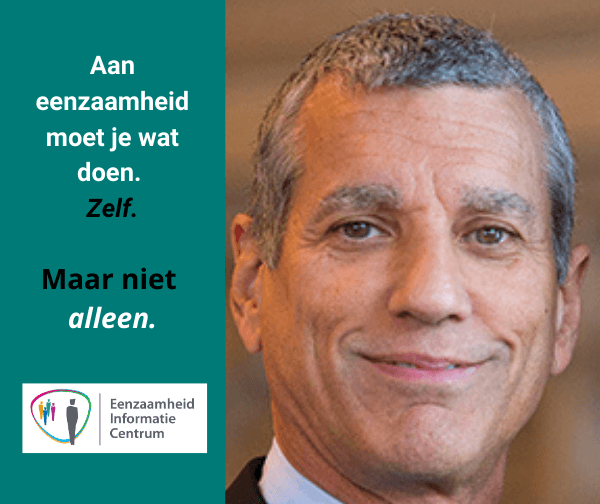Dr. John T. Cacioppo
12 June 1951 – 5 March 2018
Former Tiffany & Margaret Blake Distinguished Service Professor
Director, Center for Cognitive and Social Neuroscience
Director, Social Neuroscience Laboratory, Department of Psychology, The University of Chicago
… more to the point: one of the top researchers on loneliness.

(Lees dit artikel in het Nederlands)
What is loneliness?
The word “solitude” expresses the glory of being alone, whereas the word “loneliness” expresses the pain of feeling alone. Millions of people suffer daily from loneliness, a debilitating psychological condition characterized by a deep sense of emptiness, worthlessness, lack of control, and personal threat. Physical isolation can contribute to feelings of loneliness, but people can be lonely in a marriage, family, or crowd.
Our work with brain scans, physiological markers, and heritability analyses has allowed us to put loneliness into an evolutionary context that underscores its utility. Early in our history as a species, we survived and prospered only by banding together—in couples, in families, in tribes—to provide mutual protection and assistance. Loneliness evolved like any other form of pain. This pain served to prompt us to renew the connections we needed to insure survival and to promote social trust, cohesiveness, and collective action. Hunger, if ignored, can be followed by ravaging effects on the brain and biology, ultimately reducing a person’s ability in the wild to find and capture food. Loneliness, too, if ignored can have damaging effects that make it more difficult for an individual to escape its grips. Thus, although loneliness feels like is has no redeeming features, it is an aversive state that has evolved as a signal to change behaviour – very much like hunger, thirst, or physical pain – to motivate us to renew the connections we need to survive and prosper.
How does chronic loneliness differ from situational loneliness?
Certain situational factors heighten the risk for increased loneliness. These include loss of a meaningful relationship, feeling disrespected by others, unresolved conflict with or lacking trust in others, family problems, feeling rejected or left out, poor marital quality, infrequent contact with friends and family, few social roles, a lack of participation in voluntary organizations, and physical health symptoms and physical limitations. These situational factors can diminish the extent to which a person feels connected to others, but the resulting loneliness motivates people to reconnect with others. If these attempts are unsuccessful, the feelings of loneliness become uncoupled from the situations that aroused them, leaving one feeling chronically lonely.
How does loneliness differ from depression? How do they overlap or interact?
Loneliness and depressive symptomatology are both aversive, unpleasant states. However, feeling socially isolated (lonely) means one wants to be close to others but feels uncertain about whom one can confide in, depend on, or trust. Feeling depressed, in contrast, means that one generally feels sad and lethargic. Thus, loneliness refers to how people feel about their social connections, whereas depression refers to how people feel generally. Because loneliness can lead to depression, a person may feel both lonely and depressed. However, one can be depressed for other reasons than loneliness, and loneliness does not always lead to depression. Many students who go to college experience feelings of loneliness and sadness about the loss of contact with their friends and family, but the loneliness motivates the students to make new friends and they escape clutches of loneliness before it leads to depression.
How can someone tell if they are lonely and not depressed?
It is a sign of loneliness if you feel socially isolated from or rejected by the people around you, or if you are unhappy about your social relationships. It is a sign of depression, however, if you feel fatigued, hopeless, helpless, and sad more generally, and if even pleasant non-social events in one’s life (e.g., a beautiful sunset) seem less pleasant than normal.
How do people get stuck in chronic loneliness?
Because we need others to survive and prosper, loneliness not only makes us feel unhappy it makes us feel unsafe. That is, loneliness makes us feel threatened as well as feel pain. Threat-based responses, understandably, prompt us to look out for ourselves, which can interfere with the accurate perceptions we need to effectively connect with others and the selection of the social skills or appropriate social responses in any given interaction or occasion. Thus, when a person becomes lonely, they can get caught in a feedback loop in which the undercurrent of danger and threat associated in evolutionary terms with social isolation can promote a form of social cognition and interaction that becomes a self-perpetuating, self-fulfilling prophecy.
Are some people predisposed to loneliness?
Yes, loneliness is about 50% heritable, but this does not mean loneliness is determined by genes. An equal amount is due to situational factors. What appears to be heritable is the intensity of pain felt when one feels socially isolated. Being sensitive or insensitive are each fine, but what is important is to create a social environment that matches one’s predisposition toward feeling social pain. If one is especially sensitive, then it may benefit one’s health and well being to prioritize the development and maintenance of a few high quality relationships.
How would someone know if they are chronically lonely?
Most people feel lonely at some point in their lives, but that doesn’t mean they are chronically lonely any more than feeling pain at some point in their lives means they suffer chronic pain. If, however, a person frequently feels lonely over an extended period (e.g., months or years), then they could be characterized as chronically lonely.
What are the health risks of loneliness?
Loneliness has been linked to poor immune functioning, elevated blood pressure, higher levels of circulating stress hormones, poorer sleep quality, poorer executive functioning, obesity, alcoholism and drug abuse, even dementia in older adults. The evidence has built to the point that loneliness could be considered a serious risk factor for poor health, joining more established factors such as obesity or smoking.
How does loneliness affect behaviour?
Loneliness can affect behaviour in a variety of ways. Because it diminishes the brain’s executive functioning, it is more difficult for people who feel lonely to control impulses, such as succumbing to a guilty pleasure rather than exercising or eating a healthy diet. Because loneliness makes one feel not only unhappy but also unsafe, people who feel lonely may reach out to connect with others but unknowingly emphasize the negative, or perceived negative features of the interaction. Thus, loneliness can cause people to feel and then act distantly toward others.
How can you confront or overcome loneliness?
I suggest four simple steps, captured in the acronym EASE, for dealing with chronic loneliness.
E is for Extend Yourself. The withdrawal and passivity associated with loneliness are motivated by the perception of being threatened. To be able to test other ways of behaving without that feeling of danger, you need a safe place to experiment, and you need to start small. Don’t focus on trying to find the love of your life or to reinvent yourself all at once. Just slip a toe in the water. Play with the idea of trying to get small doses of the positive sensations that come from positive social interactions.
To improve your odds of eliciting a positive reaction-and to reduce your odds of being disappointed-you may want to confine your experimental outreach to the somewhat safer confines of charitable activities. Volunteer at a shelter or a hospice, teach elders how to use computers, tutor children, read to the blind, or help with a kids’ sportsteam. You will not necessarily receive gratitude and praise for your good deeds-that’s not what you’re after-but it is also unlikely that you will receive scathing social punishment. There will be no big scene of fulfillment in which you are at long last voted football captain or prom queen, nor will you immediately fall into a relationship with a movie star. But you may begin to feel the positive sensations that can reinforce your desire to change, while building your confidence, while improving your ability to self-regulate. Even “small talk” about sports or the weather, when it is welcomed and shared, can be a co-regulating, calming device, and the positive change it can bring to our body chemistry can help us get beyond the fearful outlook that holds us back.
Cacioppo on how to deal with loneliness
A is for Action Plan. Some people view themselves as adrift on a genetic and environmental raft over whose course they have no control. The simple realizations that we are not passive victims, that we do have some control, and that we can change our situation by changing our thoughts, expectations, and behaviours toward others can have a surprisingly empowering effect, especially on our conscious effort to self-regulate. A second inkling of control comes from recognizing that we have latitude in choosing where to invest our social energy. It does not take an enormous change to alter one’s course and destination dramatically.
Charitable activities enable us to put ourselves in the social picture with less fear of rejection or abuse, but even here some discretion is in order. Coaching kids’ soccer requires a least a little knowledge of the game, but being manager or assistant coach often requires nothing more than a willingness to show up and pass around the Gatorade and the orange slices. Trying out for the community theatre production could be awkward unless you really have acting or singing talent, but the theatre group might welcome you with open arms if you volunteered to help backstage or in the ticket office. If you’re shy with people but love animals, volunteer at an animal shelter. The animals will welcome you immediately. When you feel ready to reach out more to the humans around you, you can safely assume that the other volunteers share your interest in animal welfare, which gives you a natural basis for conversation, perhaps even connection.
Feeling lonely also make us fall victim to our own eagerness to please. Social connection does not involve superhuman strength. Committing to doing too many things for too many people in an effort to open ourselves to connection can instead make us feel overworked, stressed out, and faltering. The whole point is to be merely human-available to the common bond of humanity. Nor does anyone say that you have to become a long-suffering saint. Instead, the most adaptive model is an openness to engagement combined with realistic expectations, accurate perception of social cues-including cues that suggest caution-and realism about the type and number of commitments to take on. That may sound like a lot to manage, but when our executive brain is not distressed by feelings of isolation and threat, it is up to the task.
S is for Selection. The solution to loneliness is not quantity but quality of relationships. Human connections have to be meaningful and satisfying for each of the people involved, and not according to some external measure. Moreover, relationships are necessarily mutual and require fairly similar levels of intimacy and intensity on both sides. Even casual chitchat needs to proceed at a pace that is comfortable for everyone. Coming on too strong, oblivious to the other person’s response, is the quickest way to push someone away. So part of selection is sensing which prospective relationships are promising, and which would be climbing the wrong tree. Loneliness makes us very attentive to social signals. The trick is to be sufficiently calm and “in the moment” to interpret those signals accurately.
In the same fashion, we all need to learn that being drawn to someone’s physical appearance or status is not a good basis for a deep connection. Compatibility and sustainability depend far more on such things as common beliefs, attitudes, interests, and activities. When it comes to dating and marital success, the data show that similarity (“birds of a feather flock together”) trumps complementarity (“opposites attract”).
Deciding how to search for birds of your own feather requires selection as well. For those who tend to be more quiet than talkative, finding someone who is also comfortable with silent companionship may be a good idea. Enthusiastic readers, especially shy readers, are more likely to find people to connect with at an author’s appearance at a bookshop, or by working in a literacy program, than by going to a dance club. How you should go about trying to meet people depends on what kind of people you want to meet.
E is for Expect the Best. Social contentment can help us to be more consistent, generous, and resilient. It can make us more optimistic, and that “expect the best” attitude helps us project the best. Warmth and goodwill on one person’s part is more likely to elicit warmth and goodwill from other people-such is the power of reciprocity. With practice, any of us one can “warm-up” what we present to the world. We have more control over our thoughts and behavior patterns than we may think, but then again, no one can exercise total control of interpersonal relationships, any more than we can force an immediate and complete turnaround in the way others see us. While we wait for the change in us to register in the world around us, fear and frustration can push us back into the critical and demanding behavior associated with loneliness. This is when patiently focusing on the small physiochemical rewards of reaching out to feed others can help keep us on track.
The need for patience does not end once we begin to find greater happiness in our relationships. Even if any of us were perfect, inevitably the other people we come to know will have different perspectives. The prototypical wedding vows, “for better or for worse, in good times and in bad,” are a public proclamation of the ever-present likelihood of interpersonal friction. Even the best friends and the partners in the best marriages will disagree and hurt each other from time to time. Success in the face of this reality is served by not magnifying the moments of friction by over-interpreting them.
What can you do if someone close to you is chronically lonely?
One can help them follow the four steps outlined above. A second is to be a confidant – be there for them and follow the ABCDEs of careful listening: A).Attend – pay attention with genuine interest; B) Be there – be responsive to what is being said; C) Caring – Accept how things look from their side; D) Don’t interrupt – let them finish speaking without interruption; and E) Encourage – encourage them to say more and to do things that will help them connect to others.
Are there any resources for the lonely (programs, web sites, hot-lines, etc?)
There are not many programs or resources for the lonely. One, however, is Little Brothers: Friends of the Elderly (http://www.littlebrothers.org/) is an organization dedicated to reducing the loneliness of older adults who are living in isolation.
Where would you advise people to go to learn more about loneliness?
Several good books on the topic of loneliness have been published in the past few years. These books are a good place to start for people who want to learn more about loneliness.
Is loneliness taken seriously in the United States?
People used to think infants needed only their physical needs to be cared for, but we then learned that human contact and affection were also important for most infants to do well. We see a parallel in today’s views toward older adults. Our society pays a great deal of attention to the financial and medical conditions in which older adults live, but we pay little or no attention to their social environment – whether they feel socially isolated or they have people with whom they can interact who they trust and about whom they care. Loneliness is still regarded by most people as a personal deficit or weakness. Because loneliness is stigmatized, those who are afflicted by loneliness tend to deny it, ignore it, or “tough it out,” and those who do not feel lonely regard it as the other person’s problem. The evidence has built to the point that loneliness could be considered a serious risk factor for poor health, joining more established factors such as obesity or smoking, and the AARP Survey may draw attention to how serious the problem of loneliness can be. For risk factors like smoking and obesity, there are established treatments. These may not be easy for people, but there are methods supported by science to help a person stop smoking or reduce their weight, thereby decreasing their risk of disease. However, the correct strategy for reducing a person’s loneliness is not so obvious. Is it simply a matter of surrounding a lonely person with people, giving them more opportunities to socialize? Do they need help developing social skills? Or does a lonely person need a sort of cognitive tune-up, a realignment to break out of the cycle of negative social thoughts and perceptions? If we know that loneliness is involved in health problems, the next question is what can we do to mitigate it. We need to begin taking this question seriously and search for the best possible answers if we are to enjoy our golden years.
Are Americans at greater risk of loneliness than ever before?
It appears so. The frenetic pace with which many in contemporary society move from work to family obligations to social activities can leave many feeling at a loss for any meaningful human contact. About a quarter century ago, when Americans in a national survey were asked the number of confidants they had, the most frequent response was three. This question was asked again a few years ago, and the most frequent response was zero. This result was so surprising that many discounted its accuracy. The AARP Suvey national of loneliness, however, suggests that the number of middle age and older adults who feel lonely has increased dramatically over the past decade.



